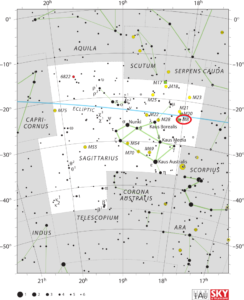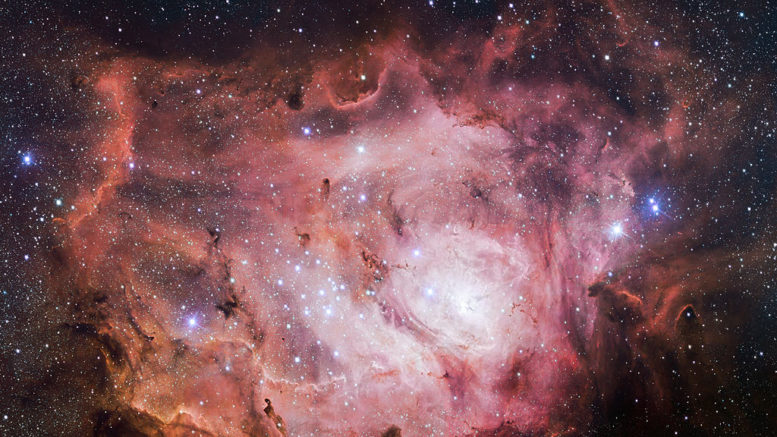Messier 8, the Lagoon Nebula is a wonderful target for observers and photographers alike. Being one of only two star-forming nebulae faintly visible to the eye from mid-northern latitudes, M8 is a wonderful sight to see. Although Messier 8 never rises very high above the horizon for observers in the Pacific Northwest, the apparent size is about three times the size of the full Moon.
| Description | |
| Visible From Pacific Northwest | May to August (summer months) |
| Best Time To Observe | August |
| Minimum Size Of Viewing Device | Binoculars |
| Object Type | Emission Nebula |
| Designations | Messier 8, M8, NGC 6523, Lagoon Nebula, Sharpless 25, RCW 146, Gum 72 |
| Right Ascension | 18h 03m 37s |
| Declination | -24°23’12” |
| Constellation | Sagittarius |
| Apparent magnitude | 6 |
| Apparent dimensions | 90 x 40 arc minutes |
| Object Radius | 55 x 20 light years |
| Distance From Earth | 4,100 light years |
History
M8 was discovered by the Italian astronomer Giovanni Battista Hodierna before 1654. Hodierna listed the nebula as No. II.6 in his catalogue. English astronomer John Flamsteed discovered the object independently around 1680 and added it as No. 2446 to his catalogue.
In 1746, Swiss astronomer Jean-Philippe Loys de Chéseaux resolved some of the stars in M8 and classified it as a cluster. The following year, French astronomer Guillaume Le Gentil observed both the Lagoon Nebula and the associated cluster.
Nicolas Louis de Lacaille listed the nebula in his 1751-52 catalogue as Lacaille III.13 and described it as “three stars enclosed in a drag of a nebula parallel to the Equator.” The category III in Lacaille’s catalogue was reserved for “nebulous stars.”
Charles Messier added the object to his catalogue as Messier 8 on May 23, 1764, when he found both the nebula and the star cluster.
Locating M8 In The Sky
Messier 8 never rises very high above the horizon for observers in the Pacific Northwest. M8 is located just above and to the right of the Teapot asterism in Sagittarius. It can be found about 5 degrees west of Lambda Sagittarii, the star that marks the top of the Teapot.

Viewing M8
In binoculars, the Lagoon Nebula appears as an oval-shaped patch with a visible bright core and a star cluster superimposed on it. Small telescopes reveal two distinct regions separated by a dark lane of dust. 8-inch and larger instruments show more dark bands through the central region, a brighter core, knots and other details of the nebula.
Photographing M8
Photographing the Lagoon Nebula can indeed be done using either a DSLR or a CMOS camera. To capture M8 using a DSLR, you can use a wide field view of either using a small telescope or attaching a lens of any size to your DSLR camera instead. Using a telescope such as a 6 or 8 inch, one can expect a good photo from an unmodified DSLR with about 2 hours of total exposure using no filters. Using filters and CMOS cameras can help bring out the colors, but the total photography timing should be similar to a DSLR time, with about 3 hours needed. There will need to be tracking in the form of autoguiding and some editing that will also need to be done.
Sources And Further Reading
Descriptions of all of Messier Objects can be found here.
https://www.nasa.gov/feature/goddard/2017/messier-8-the-lagoon-nebula
https://www.galactic-hunter.com/post/m8-the-lagoon-nebula
https://www.galactic-hunter.com/post/summer-the-15-best-astrophotography-targets

Thanks pertaining to giving the following superb content material on your web-site. I discovered it on the search engines. I will check back again after you publish more aricles.
Damn, awesome site. I in fact discovered this on google, and I’m delighted I did. I will without a doubt be coming back here more often. I have been reading and absorbing just as much facts as I can right now.
Do you always write this stuff, over you head.. Great article! Tell me more, let it come.. You are master. Laughing